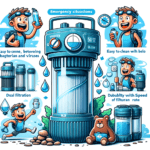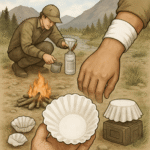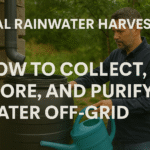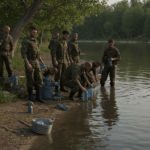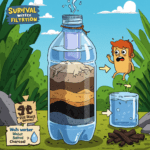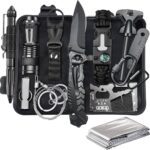Water is essential to life, yet it also carries risks. It may be polluted with chemicals, microbes, parasites and toxins which are toxic when consumed.
In an emergency or survival scenario, it’s essential to be able to filter and purify water. Knowing how to make a water filter in the wild or how to filter without having access to one can be life-saving knowledge.
Choosing a Survival Water Filter
When hiking, camping or needing clean water for cooking and cleaning in an emergency, having the appropriate survival water filter is key. Not only does having clean water make you feel better and keep your body functioning optimally, but it can also help extend your survival time in case of a crisis.
The ideal survival water filters should possess several key attributes: they filter contaminants, are user-friendly and can be reused for extended periods. Furthermore, these filters should have a filtration rate and life that provides your family with enough filtered water to survive.
For example, the Sawyer Mini is an affordable option that can be used in various scenarios. It’s small and lightweight with a long filter life. Furthermore, it can be backflushed – which is great news for those who need to reuse their filter frequently.
One excellent survival water filter is the Katadyn Vario Dual Technology Microfilter. This 0.2 absolute micron hollow fiber membrane effectively blocks bacteria, protozoa, sediments and chemicals while being backflushed with clean water to dislodge clogged particles.
Though it may be the priciest survival water filter on this list, the MSR Guardian Purifier is one of the most advanced systems available. It can self-clean itself as it pumps, saving you time from having to manually clean your survival water filter.
Other options for survival water filters include LifeStraw-style straw survival filters and bottle-style water filters that can be filled from a source and drank through an integrated cap and filter. While these are heavier and more cumbersome than pump or gravity filters, they do give you direct access to freshwater sources in case of emergency.
Cost
Filtration systems make your water safer and more enjoyable to drink by eliminating contaminants like chlorine and other chemicals that leave a bad taste or odor in the liquid. Furthermore, they can improve energy efficiency and lower water costs for homeowners.
Whole house filtration systems range in price from $1,000 to $4,200 and may include multiple stages and a reverse osmosis membrane. UV filters cost $500-$1,500 when installed with a whole home system; salt-free softeners cost $700 to $800.
In general, the more filtration stages a filter has, the costlier it is to purchase and maintain. Sediment and carbon filters that use cartridges are among the least costly to purchase and replace; however, reverse osmosis membranes can add up to $150 in recurring expenses every few years, increasing long-term ownership costs significantly.
Point-of-entry (POE) filters are relatively straightforward to install, and you can save money on labor by doing it yourself. However, whole house filtration systems require professional installation – so it may be worth investing in a plumber to get it right the first time around.
Survival water filters range in cost, so it’s essential to assess your needs and pick the most appropriate option. Whether you need a basic filter that costs under $100 or an advanced purifier costing over $300, the right decision depends on individual circumstances and budget.
A gravity water filter like the Sawyer Mini is an economical choice if you want to reduce costs. Not only does it filter drinking water, but it can also provide clean water for cooking or washing dishes. Plus, its 0.2 micron filter traps bacteria, cysts and other small organisms.
Purity
Water is one of the most essential survival resources you will ever require. Without it, you could quickly starve to death.
Ideally, try to locate a clean source of water which is suitable for drinking and cooking with. Unfortunately, this may not always be possible during disaster scenarios.
Purifying water requires multiple filtration methods and ion exchange to reach desired purity levels. This can be accomplished using a simple gravity filter, reverse osmosis system or whole home water filtration system.
Gravity filters, for instance, work by physically forcing water through a bed of finely woven filter material. Not only that but they have the capacity to adsorb impurities by trapping them within an impermeable layer.
Other filtration systems function similarly. For instance, the Pure Effect water filter utilizes zeolite mineral to attract and absorb Cesium-134, 137, Strontium-90 and other radioactive isotopes.
However, this is an intricate process requiring high precision and expert knowledge of different mineral structures. Therefore, it’s best to consult a specialist for assistance.
It is also essential to remember that while some of these filtration systems do a great job, they won’t remove all contaminants. Therefore, using a quality water filter in combination with other filtration methods helps guarantee all necessary contaminant removal is achieved.
Monitoring water’s specific resistance at 25 degrees Celsius, R-25, can be done by placing a probe between two 1 cm square plates inside an electric current-run pipe. When measurements are made in such an enclosed environment, atmospheric interference is minimal and readings can be accurate.
Reusability
Reusability is the ability to use something more than once without having to recreate it. This is an incredibly useful concept that can save both time and money on future projects.
Reuse is an increasingly common practice across a range of industries. Mobile phones feature modular designs that enable them to be reconfigured and rebuilt for different functions; cosmetics companies often package items in reusable bags; even launch systems use reusable booster rockets as part of their launch systems.
Water filters are also reusable, as they can be cleaned and reused to filter fresh water. This is especially beneficial if you live in an area prone to natural disasters or other emergencies.
Portable filters are lightweight and compact, offering options for straws, pumps, and UV methods. They can easily be carried in a backpack, pack, or bugout bag; some models even feature extra space to accommodate additional filters as needed.
Filters come in three primary forms: membranes, filtration bottles and gravity systems. Membranes trap contaminants inside porous materials like hollow fiber or survival water filters also use a carbon pre-filter to eliminate chemicals.
Membrane filters are effective at eliminating heavy metals like lead and iron from water, but cannot remove chemical pollutants like pesticides or benzene. Activated charcoal is a good alternative as it absorbs these toxins and reduces their levels in the solution.
Selecting the ideal water filter can seem like a daunting task, but it’s essential to find one that meets your requirements. There are a few factors to consider such as cost, purity and the source of your drinking water.
Maintenance
Water is one of the most essential resources you’ll need in a survival situation. It gives you the capacity to cook, bathe, and most importantly, quench your thirst. Without clean, potable water, you won’t last very long. Whether hiking through wilderness terrain, camping on top of a mountain peak, or trapped at home due to natural disasters – without it your life will drastically change for the worse.
Maintain your survival water filter regularly. Some require a flushing cycle after every use, while others just require brushing to prevent clogging. Furthermore, check for any signs of deterioration; hollow-tube filters in particular are vulnerable to freezing so make sure there’s no water inside during subzero temperatures.
